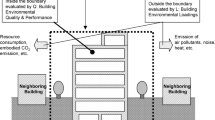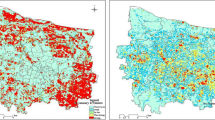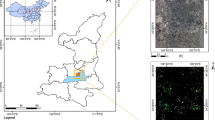Abstract
Rapid urbanization is responsible for local atmospheric pollution, which negatively affects the sustainability and human health. To offset the adverse effects, a new form of greening, termed as the green roof, is becoming one of the remedies. Previous studies and practice have validated the positive impacts of green roofs on atmospheric environment improvement, but the large-scale quantitative studies and the related urban planning still show that difficulties exist in obtaining the overall area and spatial morphological pattern of green roofs from the massive building stock. In this study, we presented a novel method based on deep learning to recognize the rooftops available and simulated the atmospheric pollutants removal potential (APRP) of green roofs in visualization. Compared with traditional methods, our method was more accurate and efficient. In this study, we recovered a trained neural network model and achieved a satisfactory 94.17% validation accuracy. According to our results, Shijiazhuang City offered great potential that if all the selected rooftops installed green roofs, 1.210465×106 kg/year pollutants would be cleaned up with dry deposition. This study provides an intuitive basis for environment policy making and urban green system planning.











Similar content being viewed by others
References
Berardi U, Ghaffarianhoseini A (2014) State-of-the-art analysis of the environmental benefits of green roofs. Appl Energy 115:411–428
Cascone S, Catania F, Gagliano A, Sciuto G (2018) A comprehensive study on green roof performance for retrofitting existing buildings. Build Environ 136:227–239
Chen M, Dai F, Yang B, Zhu SW (2019) Effects of urban green space morphological pattern on variation of PM2.5 concentration in the neighborhoods of five Chinese megacities. Build Environ 158:1–15
Dumoulin V, Visin F (2016) A guide to convolution arithmetic for deep learning. https://arxiv.org/abs/1603.07285
Grimm NB, Foster D, Groffman P, Grove JM, Hopkinson CS, Nadelhoffer KJ, Pataki DE, Peters DPC (2008) The changing landscape: ecosystem responses to urbanization and pollution across climatic and societal gradients. Front Ecol Environ 6(5):264–272
Gu C (2019) L. Urbanization: processes and driving forces. Sci China Earth Sci 62(9):1351–1360
Haaland C, van den Bosch CK (2015) Challenges and strategies for urban green-space planning in cities undergoing densification: a review. Urban For Urban Green 14(4):760–771
Ham J, Chen Y, Crawford MM et al (2005) Investigation of the random forest framework for classification of hyperspectral data. IEEE Trans Geosci Remote Sens 43(3):492–501
He BJ, Ding L, Prasad D (2019) Enhancing urban ventilation performance through the development of precinct ventilation zones: A case study based on the Greater Sydney, Australia. Sustainable Cities & Society
He BJ, Wang J, Liu H et al (2020) Localized synergies between heat waves and urban heat islands: Implications on human thermal comfort and urban heat management. Environ Res 193(11):110584 https://doi.org/10.1016/j.envres.2020.110584
Huang RJ et al (2014) High secondary aerosol contribution to particulate pollution during haze events in China. Nature 514(7521):218–222
Inglada J Automatic recognition of man-made objects in high resolution optical remote sensing images by SVM classification of geometric image features. ISPRS J Photogramm Remote Sens 62(3):236–248
Kampa M, Castanas E (2008) Human health effects of atmospheric pollution. Environ Pollut 151(2):362–367
Kanungo T, Mount DM, Netanyahu NS, Piatko CD, Silverman R, Wu AY (2002) An efficient k-means clustering algorithm: analysis and implementation. IEEE Trans Pattern Anal Mach Intell 24(7):881–892
Krizhevsky A, Sutskever I, Hinton GE (2017) ImageNet classification with deep convolutional neural networks. Commun ACM 60(6):84–90
Lecun Y, Bottou L (1998) Gradient-based learning applied to document recognition. Proc IEEE 86(11):2278–2324
LeCun Y, Bengio Y, Hinton G (2015) Deep learning. Nature 521(7553):436–444
Liu L, Lin Y, Wang L, Cao J, Wang D, Xue P, Liu J (2017) An integrated local climatic evaluation system for green sustainable eco-city construction: a case study in Shenzhen, China. Build Environ 114:82–95
Long J, Shelhamer E, Darrell T (2014) Fully convolutional networks for semantic segmentation. 2015 IEEE Conference on Computer Vision and Pattern Recognition: 3431-3440.
Luo H, Wang N, Chen J, Ye X, Sun YF (2015) Study on the thermal effects and air quality improvement of green roof. Sustainability 7(3):2804–2817
Maggiori E, Tarabalk Y, Charpiat G, Alliez P (2017) Can semantic labeling methods generalize to any city? The INRIA aerial image labeling benchmark. 2017 IEEE International Geoscience and Remote Sensing Symposium: 3226-3229
Marr D, Hildreth E (1980) Theory of edge detection. Proc R Soc B Biol Sci 207(1167):187–217
Ministry of Ecology and Environment of the People’s Republic of China (2014) China Environment Bulletin [EB/OL]. [2015-5-29]. http://www.mee.gov.cn/hjzl/zghjzkgb/lnzghjzkgb/
Odena A et al (2016) Deconvolution and checkerboard artifacts. Distill. https://doi.org/10.23915/distill.00003
Otsu N (1979) Threshold selection method from gray-level histograms. IEEE Trans Syst Man Cybern 9(1):62–66
Randen T, Husoy JH (1999) Filtering for texture classification: a comparative study. IEEE Trans Pattern Anal Mach Intell 21(4):291–310
Ronneberger O, Fischer P, Brox T (2015) U-Net: convolutional networks for biomedical image segmentation. Medical Image Computing and Computer-Assisted Intervention, 9351: 234-241.
Rowe DB (2011) Green roofs as a means of pollution abatement. Environ Pollut 159(8-9):2100–2110
Simonyan K, Zisserman A (2014) Very deep convolutional networks for large-scale image recognition, arXiv:1409.1556
Speak AF, Rothwell JJ, Lindley SJ, Smith CL (2012) Urban particulate pollution reduction by four species of green roof vegetation in a UK city. Atmos Environ 61:283–293
Tzoulas K, Korpela K, Venn S, Yli-Pelkonen V, Kaźmierczak A, Niemela J, James P (2007) Promoting ecosystem and human health in urban areas using green infrastructure: a literature review. Landsc Urban Plan 81(3):167–178
United Nations Department of Economic and Social Affairs (2018) Revision of world urbanization prospects [EB/OL]. [2018-5-16]. https://www.un.org/development/desa/publications/2018-revision-of-world-urbanization-prospects.html
Weszka JS (1978) A survey of threshold selection techniques. Comput Graphics Image Process 7(2):259–265
Wolch JR, Byrne J, Newell JP (2014) Urban green space, public health, and environmental justice: the challenge of making cities ‘just green enough’. Landsc Urban Plan 125:234–244
World Health Organization Air quality guidelines – global update 2005 [EB/OL]. [2006]. https://www.who.int/airpollution/publications/aqg2005/en/
World Health Organization. 9 out of 10 people worldwide breathe polluted air, but more countries are taking action [EB/OL]. [2018-5-2].https://www.who.int/news-room/detail/02-05-2018-9-out-of-10-people-worldwide-breathe-polluted-air-but-more-countries-are-taking-action
Yang J, Yu Q, Gong P (2008) Quantifying atmospheric pollution removal by green roofs in Chicago. Atmos Environ 42(31):7266–7273
Yuan G, Yang W (2019) Evaluating China’s atmospheric pollution control policy with extended AQI indicator system: example of the Beijing-Tianjin-Hebei Region. Sustainability 11(3):939
Code availability
The code of this article is available upon request.
Author information
Authors and Affiliations
Corresponding author
Ethics declarations
Conflict of interest
The authors declare no competing interests.
Additional information
Publisher’s note
Springer Nature remains neutral with regard to jurisdictional claims in published maps and institutional affiliations.
Appendix 1
Appendix 1
Related work
Pooling, convolution, and up-convolution are the basic operations of a convolution neural network. Through the combination of the operations, networks realize different functions and cause dimensional changes. In the U-Net, the convolution layers and max pooling layers constitute the contracting path for feature downsampling. Similarly, the up-convolution layers and convolution layers constitute the expanding path for feature upsampling. We explain pooling, convolution, and up-convolution in details as following.
The pooling layer belongs to the downsampling layer, which mainly includes three functions: (1) extend the receptive field and improve the model performance; (2) reduce the dimension of the input and simplify the convolution neural network calculation; and (3) remain feature invariant during rotation, translation, and expansion. The U-Net adopts max pooling to connect the convolution layers in the contracting path. Max pooling layers divide the input into several rectangular regions and output the maximum value for each sub region. This type of pooling preserves the texture of features more easily. Figure 12 shows an example of this operation with specific numbers.
Convolution is a many-to-one mapping process that also realizes feature downsampling and reduces the size of images but in a slightly more complicated way than the pooling. A convolution operation requires an input and a kernel and produces an output. Here, we give one element matrix with the size of 4×4 as the input.
Then, we give another element matrix with a size of 3×3 as the kernel.
According to the convolution formula, \( o=\frac{i+2p-k}{s}+1 \) (o, size of the output; i, size of the input, where i = 4; p, padding, where p = 0; s, stride, where s =1; and k:, kernel, where k = 3), it can be inferred that the output is a 2 × 2 matrix.
Furthermore, if we transform the element matrix of the input into a column vector X and transform the element matrix of the output into a column vector Y, the calculation process of the convolution can be expressed as Y = CX, where C is a deducible sparse matrix transformed from the kernel via Toeplitz matrix.
Intuitively, we fill in some specific numbers in the element to explain the operating process of the convolution in more detail in Fig. 13. The regular operating mode of the convolution can be seen: the kernel multiplies the selected region of the input, and all figures are summed to obtain the output.
Meanwhile, up-convolution is a one-to-many mapping process that recovers the size of images via upsampling, which can be regarded as the inverse operation of convolution like Fig. 14. According to the size of the input matrix and output matrix, we can easily obtain the calculation process of the up-convolution as X = CTY.
However, it should be noted that the up-convolution searches CT via network training rather than artificial setting. In addition, in actual operations, up-convolution can only recover the image size, not including the recovery of the original value (Dumoulin and Visin 2016; Odena et al. 2016). Accordingly, miscellaneous information is removed and key information is retained.
Rights and permissions
About this article
Cite this article
Huang, SY. A deep learning method for estimating the atmospheric pollutants removal potential of the large-scale environmental strategy based on green roofs. Air Qual Atmos Health 14, 725–739 (2021). https://doi.org/10.1007/s11869-020-00975-8
Received:
Accepted:
Published:
Issue Date:
DOI: https://doi.org/10.1007/s11869-020-00975-8






